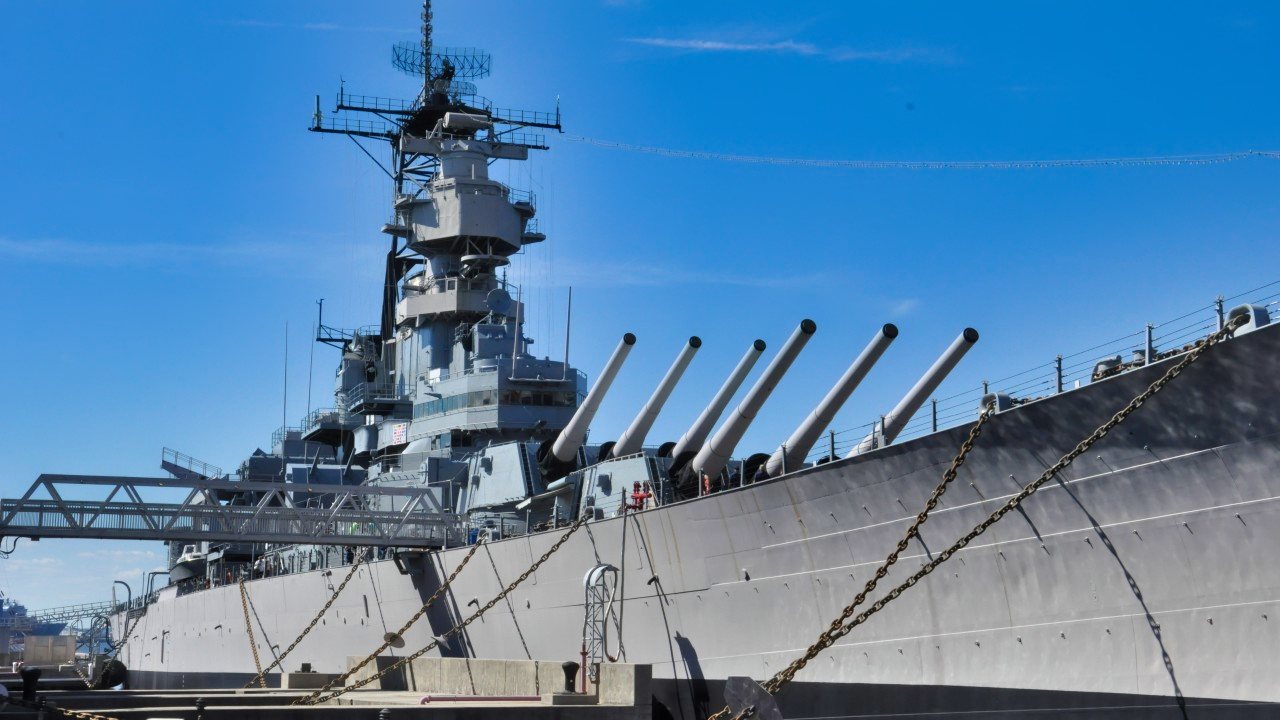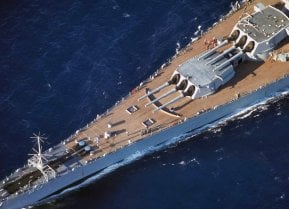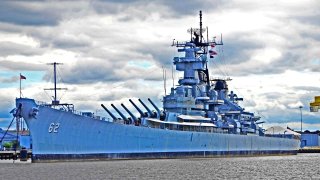Iowa-Class Battleship USS New Jersey Is Heading To Drydock for Upgrades
Following the much-needed restoration, the warship will continue to honor those veterans for many years to come.
It is hard to think of the word "small" as being applied to anything involving a former United States Navy battleship, but planned restoration work for the retired Iowa-class warship USS New Jersey (BB-62) is actually a "small contract" for Philadelphia Ship Repair. The firm will be overseeing the restoration efforts of the retired World War II battleship, set to arrive in dry dock on March 27, and around forty to fifty people will be assigned to work on the ship.
The bulk of the work will be entirely external and directed at the underwater portion of the hull—and the team at Philadelphia Ship Repair is ready for the unexpected.
USS New Jersey was last in dry dock in 1991 when she was decommissioned a final time after being recalled to service in the 1980s. According to a report from Gannet, subsequent repairs were conducted on the ship in 1999 at the former Philadelphia Naval Shipyard to make her usable as a museum, but the ship wasn't out of the water at the time.
A Temporary Home Fit For a Battleshi
Dry Dock 3 will be the ship's temporary home, and it is now being prepared for the arrival of the battleship. USS New Jersey will come to rest on a carefully planned arrangement of supporting concrete and wood blocks.
It will allow the crews to inspect the hull, including the openings that allow water to come in and leave in support of different systems. The team will further address any issues with the "blanks"—the bolt-on covers that seal those openings. The Iowa-class battleship had approximately 132 blanks installed way back in 1991 when she decommissioned, and at least one is believed to have failed.
The hull will be painted, and that will include allowing the paint to dry, refloating the warship so she can be shifted, with the warship then reset on the blocks so the rest of the hull can be painted. The thick, thorough paint job is critical to prevent corrosion and fend off sea life seeking to attack to the hull when the warship is returned to the Delaware River—which has been her home for more than twenty years.
Additionally, the USS New Jersey will have the 1,304 zinc anodes bolted on its underwater hull, which were placed as further protection against corrosion, replaced with aluminum anodes. Finally, any corroded plating will be replaced as required.
It may sound like a massive undertaking given the size of the ship—which is 887 feet, 7 inches long, and displaces 60,000 long tons under full load. Yet, it will be a fairly short stay in dry dock for the old battle wagon; its schedule currently calls for just two months spent in dry dock, while repairs are expected to cost around $10 million.
During the warship's time in Philadelphia, the USS New Jersey—the most decorated American warship for her role in World War II, the Korean War, and the Vietnam War—will still be open to walking tours underneath the ship on weekends beginning on April 6. Standard dry dock tours will provide a "behind the scenes" look at the vessel as she undergoes the restoration.
Battleship USS New Jersey: A True Warship
Known as the "Big J" or "Black Dragon," USS New Jersey was the second Iowa-class battleship to be constructed for the U.S. Navy. Launched on December 7, 1942—a year after the Japanese sneak attack on Pearl Harbor—New Jersey was commissioned in May 1943 and began her career as the flagship of the 5th Fleet under Adm. Raymond A. Spruance.
The warship proved crucial in support of U.S. Marine Corps landings across the Pacific. She returned to duty during the Korean War and again briefly during the Vietnam War. Her final service came in the 1980s when President Ronald Reagan called for a 600-ship U.S. Navy.

Decommissioned for a final time in February 1991, the USS New Jersey was towed from the Pacific to the Atlantic in 1999. The battleship earned nine battle stars for her World War II service, four for the Korean War, three for the Vietnam War, and three for action in Lebanon and the Persian Gulf region.
She is now a museum at Camden, New Jersey—a testament to the sailors who served on her in wartime and peacetime. Following the much-needed restoration, the warship will continue to honor those veterans for many years to come.
Author Experience and Expertise: Peter Suciu
Peter Suciu is a Michigan-based writer. He has contributed to more than four dozen magazines, newspapers, and websites with over 3,200 published pieces over a twenty-year career in journalism. He regularly writes about military hardware, firearms history, cybersecurity, politics, and international affairs. Peter is also a Contributing Writer for Forbes and Clearance Jobs. You can follow him on Twitter: @PeterSuciu. You can email the author: [email protected].
All images are Creative Commons.


